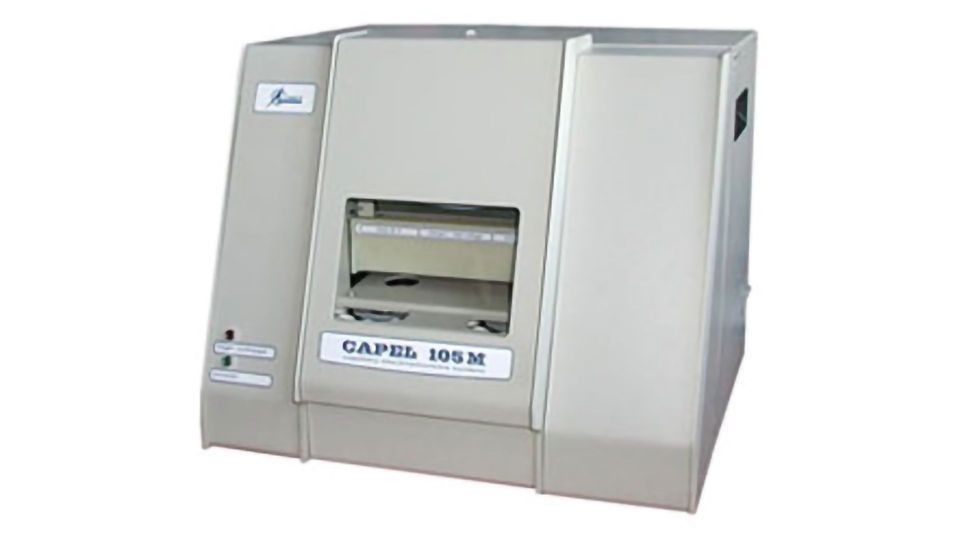LEC Changed Technique of Analysis of Metals in Spirits to Capillary Electrophoresis

Capillary electrophoresis system CAPEL-105M
Want to listen to this article for FREE?
Complete the form below to unlock access to ALL audio articles.
Read time: 1 minute
LEC company, one of the leading spirit control companies in the Cognac region, managed to switch from atomic absorption (AA) spectrometry to capillary electrophoresis (CE) to analyze metals in spirits using Capel-105M.
LEC found the CE systems from Lumex Instruments to be the most cost-effective, user-friendly, and reliable solution to solve its analytical tasks in oenology because of high level of accuracy and versatility of CE compared to other methods. Although atomic absorption spectrometry is the most commonly used technique for metal determination in wines, starting at the end of 2018, LEC switched from this technique to capillary electrophoresis to quantify iron (II) and copper. Capel-105M had significant and important benefits over the AA spectrometer that was used by LEC before: simple sample preparation, fast and accurate analysis, and no need for a specific calibration for each element. Moreover, this switch has reduced the maintenance cost for LEC since it reduced the number of instruments used for its analyses.
Capillary electrophoresis proved to be a powerful and reliable technique to analyze the diversity of wine and brandy compounds. CE system Capel provides a number of advantages for the analysis of wine and brandies, including short analysis times, low waste generation, very high level of accuracy, and a diverse range of applications.
The LEC company purchased its first CE system Capel-105M in 2011 to determine a number of compounds in wine and spirits, like aromatic aldehydes in cognac and brandies, and organic acids in wine materials. The analytical protocols developed by Lumex Instruments using CE have benefits over other commonly applied techniques such as titration or enzymatic method. One of the most significant of them is the determination of multiple compounds just in one run. Besides that, LEC analyzes organic acids, sugars (fructose, glucose, and sucrose) in food and beverages, and inorganic cations in wine with the CE method. Today, LEC uses two Capel-105M systems.
Founded in 1994, the LEC laboratory is internationally recognized for its analysis and technical expertise in the areas of barrel making and spirits. The company performs about 3 thousand analyses of wines and wine materials per year and has COFRAC accreditation.
LEC found the CE systems from Lumex Instruments to be the most cost-effective, user-friendly, and reliable solution to solve its analytical tasks in oenology because of high level of accuracy and versatility of CE compared to other methods. Although atomic absorption spectrometry is the most commonly used technique for metal determination in wines, starting at the end of 2018, LEC switched from this technique to capillary electrophoresis to quantify iron (II) and copper. Capel-105M had significant and important benefits over the AA spectrometer that was used by LEC before: simple sample preparation, fast and accurate analysis, and no need for a specific calibration for each element. Moreover, this switch has reduced the maintenance cost for LEC since it reduced the number of instruments used for its analyses.
Capillary electrophoresis proved to be a powerful and reliable technique to analyze the diversity of wine and brandy compounds. CE system Capel provides a number of advantages for the analysis of wine and brandies, including short analysis times, low waste generation, very high level of accuracy, and a diverse range of applications.
The LEC company purchased its first CE system Capel-105M in 2011 to determine a number of compounds in wine and spirits, like aromatic aldehydes in cognac and brandies, and organic acids in wine materials. The analytical protocols developed by Lumex Instruments using CE have benefits over other commonly applied techniques such as titration or enzymatic method. One of the most significant of them is the determination of multiple compounds just in one run. Besides that, LEC analyzes organic acids, sugars (fructose, glucose, and sucrose) in food and beverages, and inorganic cations in wine with the CE method. Today, LEC uses two Capel-105M systems.
Founded in 1994, the LEC laboratory is internationally recognized for its analysis and technical expertise in the areas of barrel making and spirits. The company performs about 3 thousand analyses of wines and wine materials per year and has COFRAC accreditation.

